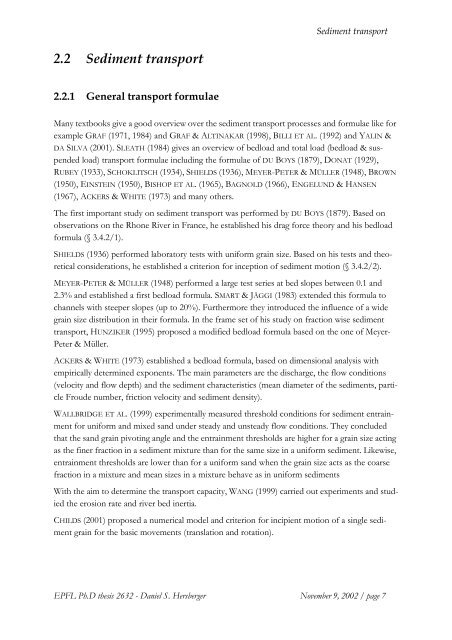pdf, 12 MiB - Infoscience - EPFL
pdf, 12 MiB - Infoscience - EPFL
pdf, 12 MiB - Infoscience - EPFL
Create successful ePaper yourself
Turn your PDF publications into a flip-book with our unique Google optimized e-Paper software.
Sediment transport<br />
2.2 Sediment transport<br />
2.2.1 General transport formulae<br />
Many textbooks give a good overview over the sediment transport processes and formulae like for<br />
example GRAF (1971, 1984) and GRAF & ALTINAKAR (1998), BILLI ET AL. (1992) and YALIN &<br />
DA SILVA (2001). SLEATH (1984) gives an overview of bedload and total load (bedload & suspended<br />
load) transport formulae including the formulae of DU BOYS (1879), DONAT (1929),<br />
RUBEY (1933), SCHOKLITSCH (1934), SHIELDS (1936), MEYER-PETER & MÜLLER (1948), BROWN<br />
(1950), EINSTEIN (1950), BISHOP ET AL. (1965), BAGNOLD (1966), ENGELUND & HANSEN<br />
(1967), ACKERS & WHITE (1973) and many others.<br />
The first important study on sediment transport was performed by DU BOYS (1879). Based on<br />
observations on the Rhone River in France, he established his drag force theory and his bedload<br />
formula (§ 3.4.2/1).<br />
SHIELDS (1936) performed laboratory tests with uniform grain size. Based on his tests and theoretical<br />
considerations, he established a criterion for inception of sediment motion (§ 3.4.2/2).<br />
MEYER-PETER & MÜLLER (1948) performed a large test series at bed slopes between 0.1 and<br />
2.3% and established a first bedload formula. SMART & JÄGGI (1983) extended this formula to<br />
channels with steeper slopes (up to 20%). Furthermore they introduced the influence of a wide<br />
grain size distribution in their formula. In the frame set of his study on fraction wise sediment<br />
transport, HUNZIKER (1995) proposed a modified bedload formula based on the one of Meyer-<br />
Peter & Müller.<br />
ACKERS & WHITE (1973) established a bedload formula, based on dimensional analysis with<br />
empirically determined exponents. The main parameters are the discharge, the flow conditions<br />
(velocity and flow depth) and the sediment characteristics (mean diameter of the sediments, particle<br />
Froude number, friction velocity and sediment density).<br />
WALLBRIDGE ET AL. (1999) experimentally measured threshold conditions for sediment entrainment<br />
for uniform and mixed sand under steady and unsteady flow conditions. They concluded<br />
that the sand grain pivoting angle and the entrainment thresholds are higher for a grain size acting<br />
as the finer fraction in a sediment mixture than for the same size in a uniform sediment. Likewise,<br />
entrainment thresholds are lower than for a uniform sand when the grain size acts as the coarse<br />
fraction in a mixture and mean sizes in a mixture behave as in uniform sediments<br />
With the aim to determine the transport capacity, WANG (1999) carried out experiments and studied<br />
the erosion rate and river bed inertia.<br />
CHILDS (2001) proposed a numerical model and criterion for incipient motion of a single sediment<br />
grain for the basic movements (translation and rotation).<br />
<strong>EPFL</strong> Ph.D thesis 2632 - Daniel S. Hersberger November 9, 2002 / page 7
















